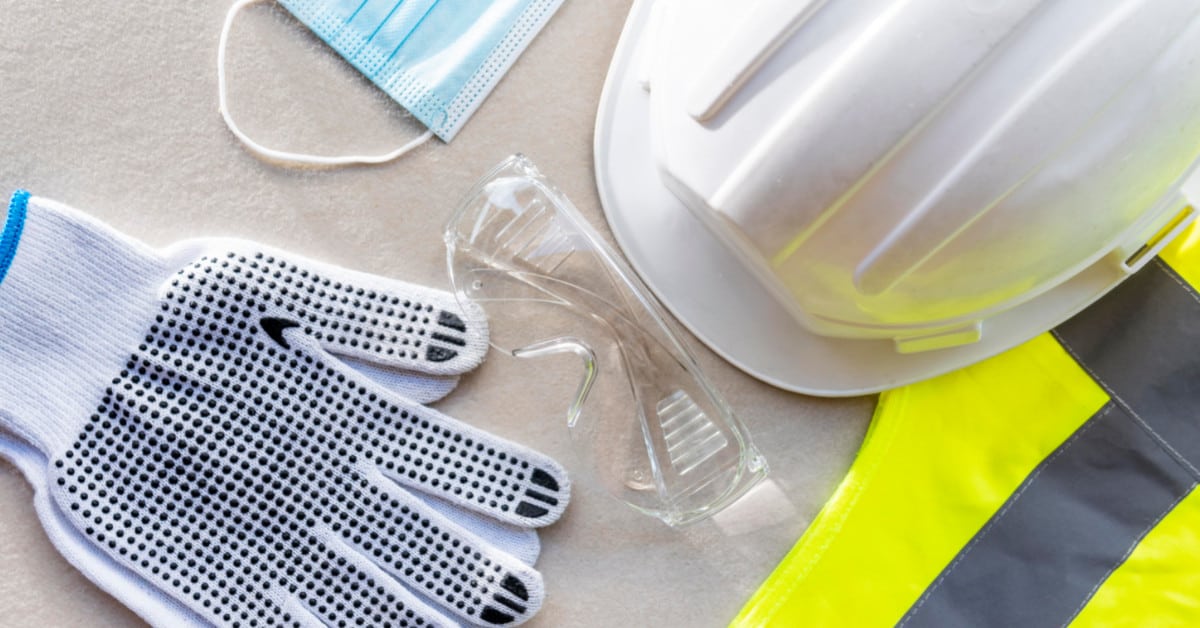Construction sites are running more efficiently than ever, thanks to enhanced technologies and systems. However, the level of safety of workers has been difficult to maintain. Construction Site Safety checklist ensures your operations run safely and smoothly on a daily basis.
According to OSHA, the construction industry is responsible for about 20% of all workplace deaths. The “fatal four” account for nearly half of all deaths:
- Falls – These account for about 338 deaths per year amounting to 33.5% of all fatalities.
- Strikes from an object – These accounts for about 112 deaths per year amounting to 11.1% of all fatalities.
- Electrocutions – These accounts for about 86 deaths per year amounting to 8.5% of all fatalities.
- Caught-in, compressed or crushed by collapsing structures, equipment, or material – About 55 deaths per year amounting to 5.5% of all fatalities.
OSHA Construction Site Safety Checklist
The construction site safety checklist by OSHA below may assist you in avoiding hazards that can result in injuries, illnesses, or fatalities. Note that while some of the bullet points are based on mandatory standards, executing audits based on these checklists is not mandatory. “As always, be cautious and seek help if you are concerned about a potential hazard,” says OSHA.
1. Personal Protective Equipment (PPE)
According to the construction site safety checklist, every construction worker and everyone on-site must have the proper personal protective equipment (PPE) for whatever work or job they are doing. Wearing incorrect safety equipment or having ill-fitting gear can expose a person to health and safety concerns, both in the short and long term.
One key aspect of PPE is respiratory gear, which protects workers from inhaling dust, vapors, and other particles. If this equipment is not worn correctly, is ill-fitting, or does not work well, it may cause lung damage over time.
All PPEs must be thoroughly inspected before usage to ensure that there is enough for each employee and that the equipment is not damaged or compromised. This inspection includes the following checks:
- Hardhats for any cracks or dents
- Goggles and eyewear protection for scratches or chips
- Safety harnesses for signs of wear, tears, or stretching
- Respiratory protection for signs of damage and improper sanitation (be sure that each piece is cleaned properly between use)
- Safety boots, which should be required and have metal toe protection and a non-slip grip
- Gloves for any rips or tears
2.Scaffolding
Scaffolding is a very important point in the construction site safety checklist. Falls are the biggest cause of injury and death on construction sites, as previously stated. These types of accidents are usually caused by unsafe scaffolding and ladders. Falls also are typically caused by a lack of sufficient protection on the job site. In fact, failure to meet fall protection criteria is the most common OSHA health and safety infraction for construction sites.
OSHA requires that any surface six feet or higher off the ground have a guardrail, safety net, or personal fall arrest system in place. Covers must be installed on any walking surfaces (such as roofs or scaffold walkways) to protect any holes or openings.
Not only should you double-check these protective systems on your construction safety checklist, but also you should ensure that they are structurally sound. OSHA requires that all scaffolds meet OSHA construction site safety checklist requirements for width, support, placement, and distance from potential hazards such as power lines.
3. Electrical Equipment
Electrical equipment is a major source of construction safety concerns. Supervisors must look for potential electrocution risks such as loose wires, sparks, or cords near water sources.
For hazardous energy control, all construction sites must have the proper lockout/tagout system. Team managers and employees in charge of managing any energy source (electrical, mechanical, chemical, hydraulic, or thermal) should be properly trained to implement and follow the proper system to avoid these safety hazards.
The lockout/tagout system should be reviewed regularly to ensure that it is being used appropriately and that all equipment is being tested, positioned, and used properly. This involves marking electrical circuits, using grounded extension cables, and keeping specified equipment away from other things that could cause damage, fire, or electrocution.
4. Signage
Signage is one of the important points of the construction site safety checklist is used to protect both workers and visitors or passersby from potentially dangerous construction hazards. These signs must warn of any possible risks, such as:
- Falling objects
- High voltage
- Slippery surfaces
- Flammable materials
- Personal protective gear required (eye, vests, work boots, or head protection)
- Authorized personnel only areas
Signage for areas where there is a steep, loose deck footing, or incomplete scaffolding must be displayed prominently on the construction site. Any elevated surfaces should have the maximum load capacity rating indicated. Failing to have the proper signs could result in serious injury – as well as a large violation fee for failing to meet OSHA compliance standards.
5. Openings
Each opening on the floor, wall, or ceiling must have a secured cover, guardrail, or another type of fall protection secure. This must be more than a warning tape or warning sign. If a fall is likely to cause an injury, a safety rail must be installed.
Toeboards should be installed at the edges of any floor openings (such as an opening for a stairway or elevator). These toeboards can prevent things from sliding down and opening, which might possibly impact or cause damage.
6. Safety Data Sheets
A big item in the construction site safety checklist is to make it widely available to the public to update accurate safety data sheets. SDS forms provide workers and emergency response personnel with the relevant information in relation to the handling of certain dangerous materials. This includes the use of chemicals or other dangerous materials on the site.
Safety Data Sheets must contain the following information:
- Identification of the product
- All hazardous ingredients and required label elements (symbols identifying hazards)
- First-aid measures (symptoms or effects and required treatments)
- Extinguishing techniques if the element is flammable
- Accidental release measures (protective equipment required, proper cleanup methods)
- Handling and storage requirements
- Exposure control listing OSHA’s Permissible Exposure Limits (PELs) and Threshold Limit Values (TLVs)
- Physical and chemical properties of the substance’s characteristics
- Stability and reactivity information
- Toxicological information
- Ecological information on environmental impact
- Disposal information (proper practices, recycling information)
- Transport information
- Regulatory information for safety, health, and environmental regulations
- Information on date of preparation or last revision
The SDS forms must be accessible and the suitable form must be adequately identified for all dangerous substances. The information is available and updated with the dates of usage as needed. It is important to check. This ensures that the chemical is properly treated.
7. Cranes and Forklifts
Heavy machinery, such as cranes and forklifts, must be inspected regularly to ensure that no rigging equipment is damaged. Furthermore, the equipment itself must be inspected before each use to ensure its safety.
Crane safety checklist for construction site should include:
- Making sure all cranes and derricks are at least 10 feet away from electrical power lines.
- An electrical grounding structure is available when working near energized transmitter towers.
- Load capacity ratings, load charts, operating speed, and instructions are clearly posted.
- Any areas accessible within the wing radius are barricaded.
- Platforms and walkways for the crane are free of hazards and have anti-skid surfaces.
- Operators must complete a crane safety training program and be qualified, evaluated, and certified by a nationally accredited organization.
- Rigger and Signal persons need to take the appropriate training course and have relevant work experience.
Forklift construction site safety inspection checklist should include:
- Daily inspection safety of brakes, steering, forks, tires, and horns.
- Capacity, operation, and maintenance instruction signs are visible and updated.
- Material handling equipment is available for specifically designated purposes.
- Sufficient headroom for both the forklift and operator when going underneath installations, lights, pipes, etc.
- Operators complete forklift training and have the proper certifications for the specific vehicles used.
Best Practices for Health and Safety Checklist for Construction Site
Your field crews must fill out the daily construction site safety inspection checklist to document safety and health measures.
The process for construction site safety checklist usually goes like this:
- The office sends a form to the field.
- The field prints it out and completes it on the site.
- The field scans it and sends it back to the office.
- The office reviews the completed checklists to ensure high compliance and quality.
That’s not to include all the back-and-forth, additional emails, and unnecessary check-ins. It will take much more time and resources to complete the overall picture if the construction site safety checklist is missing information or isn’t filled out correctly.
Welding Safety Checklist in Construction Site
A welding safety checklist can also be used during site walkthroughs to note the condition of the ventilation system, flammable materials on site, and welding hazards and control.
Welding Safety Equipment List:
When performing weld in the welding industry, it is important to wear the proper PPE. It serves to protect welders against unintentional injuries such as skin burns, blindness, and overexposure to fumes and gases. Welders can be protected against welding dangers by using the equipment listed below:
- Welding helmet – wearing a welding helmet, hood, or mask can protect welders from sparks and radiation emitted by the arc that can quickly damage the skin and eyes.
- Eye protection – this includes goggles or hand-held face shields. This would help prevent eye damage or loss of vision.
- Respirators – this would protect welders from inhalation of harmful fumes and gases to enter the body.
- Flame-resistant welding gloves – the working hands are the closest proximity to the arc. Wearing flame-resistant welding gloves can lessen exposure to intense heat and radiation.
- Protective suits – this could protect the welder from extreme temperatures, flames, and sparks.
- Welding-specific work boots – this would protect the top of the foot from flames and sparks
Download Free PPE Construction Site Safety Checklist Template from HERE
Read also: Site Instruction in Construction









